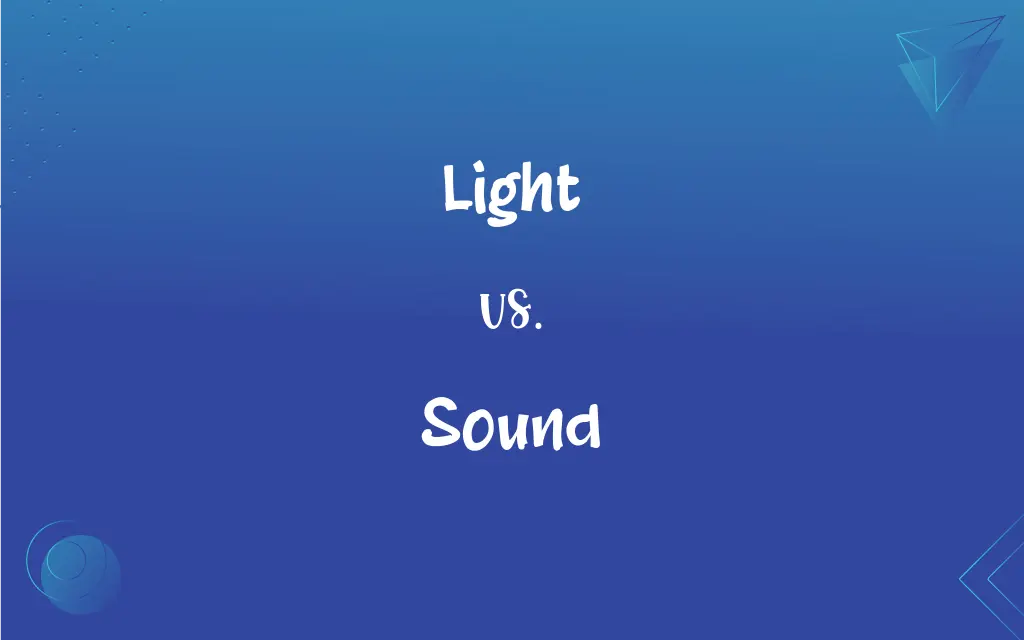Light vs. Sound: What's the Difference?
Edited by Aimie Carlson || By Harlon Moss || Published on January 12, 2024
Light is electromagnetic radiation visible to human eyes, while sound is a mechanical wave that travels through mediums like air or water.

Key Differences
Light, a form of electromagnetic radiation, can be seen by the human eye and is crucial for vision. Sound, in contrast, is an auditory sensation created by vibrating objects and is perceived through the ears.
Light travels at an incredibly fast speed (approximately 300,000 kilometers per second in a vacuum), making it a fundamental aspect of many natural phenomena. Sound, however, travels much slower, around 343 meters per second in air, and its speed varies with the medium.
Light waves are transverse, meaning their oscillations are perpendicular to the direction of wave travel. Sound waves are longitudinal, oscillating parallel to the direction of wave propagation.
Light can travel through a vacuum, like space, where it plays a vital role in astronomy and cosmology. Sound, however, requires a medium like air, water, or solid to travel, limiting its range and applications.
The spectrum of light includes various colors, each with a specific wavelength, whereas the spectrum of sound comprises different frequencies, perceived as pitch.
ADVERTISEMENT
Comparison Chart
Nature
Electromagnetic radiation
Mechanical wave
Speed
~300,000 km/s in vacuum
~343 m/s in air
Wave Type
Transverse
Longitudinal
Medium for Travel
Can travel through vacuum
Requires a physical medium
Human Perception
Visible as colors
Audible as pitches
ADVERTISEMENT
Measurement
Measured in wavelengths (nanometers)
Measured in frequency (Hertz)
Effect on Materials
Can be reflected, refracted, absorbed
Can be reflected, absorbed, transmitted
Energy Transmission
Carries radiant energy
Carries mechanical energy
Uses
In vision, photography, communications
In communication, echolocation, diagnostics
Sensory Reception
Perceived by eyes
Perceived by ears
Light and Sound Definitions
Light
Light is used to describe something of low weight or little force.
She packed a light bag for her weekend trip.
Sound
Sound can refer to an idea or impression conveyed by words.
His argument didn't sound convincing to the audience.
Light
Light refers to an area where a source of light falls.
He moved into the light to read the note more clearly.
Sound
Sound can also refer to a narrow stretch of water.
They sailed through the sound as the sun set.
Light
Light can imply a particular expression in someone's eyes.
A mischievous light twinkled in her eyes as she planned the surprise.
Sound
Sound is vibrations that travel through the air or another medium and can be heard.
The sound of the waves crashing against the shore was soothing.
Light
Light can mean not intense or severe.
The teacher gave the class a light homework assignment.
Sound
Sound is used to describe something that is in good condition; solid and reliable.
The building's structure is sound and well-maintained.
Light
Electromagnetic radiation that is visible, perceivable by the normal human eye as colors between red and violet, having frequencies between 400 terahertz and 790 terahertz and wavelengths between 750 nanometers and 380 nanometers. Also called visible light.
Sound
Sound can mean to emit or cause to emit sound.
The alarm clock sounded at 6 AM, waking her up.
Light
Light is the natural agent that stimulates sight and makes things visible.
The morning light filtered through the curtains, brightening the room.
Sound
Vibrations transmitted through an elastic solid or a liquid or gas, with frequencies in the approximate range of 20 to 20,000 hertz, capable of being detected by human organs of hearing.
Sound
Transmitted vibrations of any frequency.
FAQs
How do we see light?
We see light when it enters our eyes and stimulates the retina.
What are the colors of light?
Light's colors range from red to violet in the visible spectrum, each with different wavelengths.
How is sound produced?
Sound is produced when an object vibrates, creating pressure waves in the air or other mediums.
What affects the speed of sound?
The speed of sound varies with the medium; it travels faster in solids and liquids than in gases.
What is the speed of light?
The speed of light is approximately 300,000 kilometers per second in a vacuum.
What is sound?
Sound is a type of energy made by vibrations and is heard when these vibrations reach our ears.
Do light and sound waves behave differently?
Yes, light waves are transverse while sound waves are longitudinal.
What is light?
Light is electromagnetic radiation within a certain portion of the electromagnetic spectrum, visible to the human eye.
How does light travel?
Light travels in straight lines as waves and can move through a vacuum.
Why is light faster than sound?
Light waves, being electromagnetic, can travel through a vacuum, whereas sound waves need a medium, making them slower.
Can sound travel in a vacuum?
No, sound requires a medium like air, water, or solids to travel.
Can light bend?
Yes, light can bend due to refraction when it passes through different mediums.
What is the color temperature of light?
Color temperature refers to the color appearance of a light source, measured in Kelvins.
Can sound be used to measure depth?
Yes, sonar uses sound waves to measure the depth of oceans.
How do we hear sound?
Sound waves enter the ear and are converted into electrical signals, which the brain interprets.
What are the uses of sound?
Sound is used in communication, music, echolocation, and medical diagnostics.
Is light always visible?
No, only a small part of the electromagnetic spectrum is visible as light.
Can sound waves be harmful?
High-intensity sound waves can be harmful, causing hearing loss or discomfort.
What are the uses of light?
Light is used in vision, photography, communication, and many scientific applications.
Is the speed of light constant?
The speed of light is constant in a vacuum but can slow down in other mediums like water or glass.
About Author
Written by
Harlon MossHarlon is a seasoned quality moderator and accomplished content writer for Difference Wiki. An alumnus of the prestigious University of California, he earned his degree in Computer Science. Leveraging his academic background, Harlon brings a meticulous and informed perspective to his work, ensuring content accuracy and excellence.
Edited by
Aimie CarlsonAimie Carlson, holding a master's degree in English literature, is a fervent English language enthusiast. She lends her writing talents to Difference Wiki, a prominent website that specializes in comparisons, offering readers insightful analyses that both captivate and inform.






































































